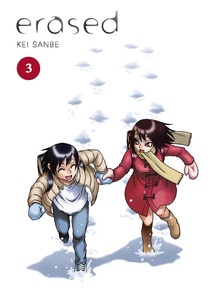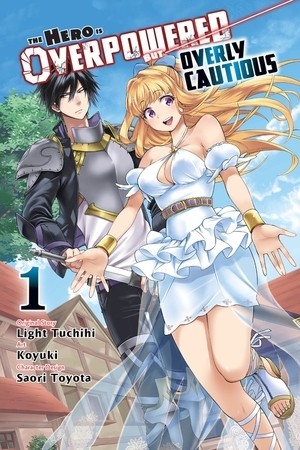Erased Volume 3 begins with Satoru shifting the focus of his heroics from Kayo Hinazuki, who no longer needs to be saved, to a wide-angle view of the enigmatic killer. While Satoru frustrates the murderer’s efforts to abduct Hiromu and Aya Nakanishi, Satoru realizes that Misato now fits the loner profile of his victims, as the class ostracized her for shaming Kayo.
When Misato enters the girls’ bathroom at a hockey game, and doesn’t exit, Satoru persuades his teacher Yashiro to follow a departing truck owned by the Shiratoris. On the road, Yashiro reveals that he is the killer.
Yashiro secures Satoru in the car and sets it to plow into an icy lake. As Satoru drowns, we go for a dip in Yashiro’s equally icy origin. While Yashiro’s origin story is rife with pettiness and commonplace motivations, they become epic in scope, almost like a supervillain origin story, due to his fixation on a buddhist parable. Since this is somewhat important to the denouement of this novel, as it may tie in to Satoru’s denouement and a surprise appearance at the end, I’ll reproduce the text here:
…I read a short story called ‘The Spider’s Thread.” ..It’s about Kandata, a fiendish sinner in life who went to hell after his death. The only good deed he’d ever done was saving the life of a spider. Because of that single act of benevolence, Buddha gave Kandata a chance. Buddha lowered a spider’s thread down into hell and Kandata began to climb up toward paradise. When other dead denizens started to climb behind him, Kandata said, ‘this is my thread,’ and kicked them off one by one. Then the thread broke and Kandata himself plunged back to hell once again. Buddha said ‘oh, merciless man,’ and walked away.
Satoru awakes from a coma fifteen years later after the reader glimpses the sacrifices made by his long-suffering mother, Sachiko. His memories are a tossed salad of childhood episodic memory and adult muscle memory, such as the refined manga skills that seem out of place in a coma patient that should have the skills of a twelve year old. His brush with death, the entirety of his adult life, his thrice-lived twelfth year, and all knowledge of time travel, are a fog to him. Satoru’s body is in better condition, because Sachiko fed him and forced his comatose body through a regimen of physical therapy.
Kenya, Hiromu, and Hinazuki visit Satoru in pages of bittersweet pageantry that hammer home both the heaviness of Satoru’s defeat and the magnitude of his victory. Though Satoru changed history, Yashiro crippled him for his interference, and he remembers neither the bitter nor the sweet. When the reader learns that Hiromu and Kayo married during Satoru’s coma, it may provoke an existential crisis not unlike Fred Savage’s in The Princess Bride. “You mean Kayo and Satoru get married, right grandpa?” “Do you want me to finish this?”
When paparazzi sniff around Satoru’s hospital, hoping to catch an interview, Airi makes a very unexpected appearance, chasing them off, and possibly jogging Satoru’s memory. Attentive readers will have noticed by now that Satoru and Airi were fated to be, and no amount of time travel or shipping on the part of the reader can cut Satoru’s time-travel web, a shifting link of causality upon which Satoru descended into the past to redeem his future.
This, of course, recalls Yashiro’s Buddhist parable. While Yashiro has no time-travel ability, he is a clever man who has moments of clarity approaching metaconsciousness, in which he uses these glimpses of his own narrative for personal satisfaction, and when his spree of murders ends in volume 4, the reader will be unsurprised to see that Yoshiro is at the top of a kind of metaphorical thread. If you’ve watched the anime, you are already comparing his fate to Kandata’s. By contrast, Satoru used his gift not only for personal enlightenment and redemption, but to save others. Unlike Kandata and Yashiro, we can imagine that Satoru may climb his time-travel thread all the way to its end. Satoru’s web is a double-knit, composed not only of his time travel gift but the fixed point of Airi, who cannot be repressed from Satoru’s revised 2004 continuity, even when she isn’t supposed to make her first appearance in his life until 2006.
While the plot is strong, Sanbe prefers to follow his characters through page after page of exploration. Aside from flashbacks and contemplation, most of chapters thirty-four and thirty-five, set during his rehab, are drawn from the perspective of Satoru in his hospital bed. That the mangaka resists the temptation to write “months later” to shortcut Satoru’s convalescence, and that so much of Erased is written with the viewpoint character in a hospital bed, is a powerful feat. It changes the disposition of the concluding scenes of this volume, so that when his childhood friends come one after one to see him, their discussions are so lopsided that they often seem staged monologues. Whether weakness of body or weakness of heart holds him back, it is hard to watch Satoru forced into a following and passive role after he used the bulk of three double volumes to remold his past self into a leader and hero. By the time the last pages are turning, the reader is ready for some sunshine, and is not disappointed when Airi’s paparazzi-punching appearance jogs an unexpected response in Satoru.
Artistically, Erased is an appealing paradox of understated line art bordered by an emphatic world of alternating shadows and white space. Erased is stuffed with subtleties and hammer-blows; on the one hand, a tree in winter is drawn with a black squiggle, and on the other, Yashiro’s reptilian lip-curl slithers through page after page. Kei Sanbe has a strong sense of gravitas, giving Satoru’s coma bed a two page spread, forcing the readers’ eyes to linger on his broken body, his mother about to spin one of his childhood soundtrack LPs.
Since Goodnight Punpun’s completion, Erased is a strong contender for the best manga currently being published in an English print edition. Full of poignancy, strong character moments—even from the psychopathically likable villain Yashiro, but especially from Sachiko, the breakout character of volume 4—and a sustained meditation on the effects of time travel on memory and the human psyche, Erased is a fantastic contribution to sequential art.
Erased Volume 3 arrived in stores on November 7th, 2017, and if you can’t find a copy, here’s a list of online booksellers on the Yen Press web page.
Yen Press sent the review copy.



November 29, 2017
Your writing is very impressive.
Especially the expression of Airi as Spider’s Thread was very nice.
I also thought of his Time-Leaf ability as Spider’s Thread.
I also thought of Airi as the blessing of his life
But I never thought of it as Spider’s Thread.
(Whether this is just your simple analogy, or whether you think of it as an “author’s intention”)
I want to have a more in-depth conversation with you.
I did a great deal of research on it. Obviously you know what you do not know, and I also crave information.
I promise not to bother you. If you have an intention, to comment on my comment
November 29, 2017
P.S.
Erased originally consists of 9 volumes.
I know that the English version’s one volume consists of original two volumes
If so, do you know how the last one will be released?